- Sado Island Travel Model Course Guide
- Kuninaka area with historical sites and historical romance
Kuninaka area with historical sites and historical romance
-
Departure

Jinmeniwa is an oddly-shaped rock approximately 10m high, standing on the Koshi no Nagahama seashore stretching from Mano to Ogi. The rock is made of green-coloured andesite, and it is called "Jinmeniwa (human face rock), as it resembles to a person looking into far distance. Jinmeniwa is a popular location to take photos with the background of Mano Bay, and the rock stands out from all of the other numerous unique rock formations in Sado.
-
5 minutes by carDestination B
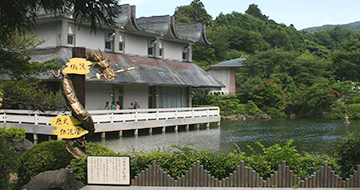
Full-size robots intriguingly tell of the history and legends of Sado. On the first floor, famous scenes with historical significance are introduced by robots in elaborate clothing which are exact replicas of historical figures. Witness Emperor Juntoku mourning his fate with the moon at the place of his exile, or a famous Tsukahara debate between Nichiren and other priests from other schools, and Zeami (14th-15th-century Noh actor and playwright) dancing to pray for rains. On the second floor, photographs and art objects inspired by Sado's ambiance are on exhibit. Shodo Sasaki Museum is located within the museum, where the works of lost-wax casting by Shodo Sasaki, a living national treasure, are on display. You may also enjoy the taste of Sado at a restaurant on site.
-
Approximately 3 minutes by carDestination C
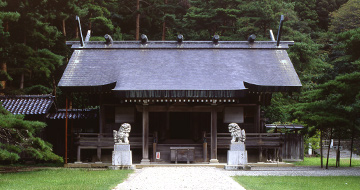
Shinrinji Temple used to look after the cremation mound of Emperor Juntoku. Through the religious reform movement (which promotes shinto and destructs Buddhist temples) in the Meiji Period (late 19th century), Shinrinji was recognised as a prefectural shrine in 1874 and renamed it as Manogu Shrine. Along with Emperor Juntoku, it enshrines Michizane Sugawara (statesman worshipped as a god of learning) and Suketomo Hino (disgraced court noble exiled to Sado). The present shrine buildings were erected in 1920. Torii Gate, Shinkyo (sacred bridge), Shinmon Bridge, and shrine office were newly built, and the sanctuary was enlarged with an extension of the approach. Manogu Shrine treasures a single edged dagger, a ink stone, a fan, a suspension vase, and so on, which are considered as mementos of Emperor Juntoku.
-
Approximately 1 minute by carDestination D
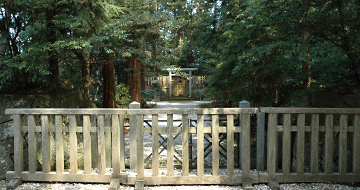
Mano Goryo Mausoleum is the official cremation mound of Emperor Juntoku. Emperor Juntoku was forced into exile on Sado when he lost the Jokyu Disturbance. After twenty-two years, he passed away in 1242, at the age of forty-six. His body was cremated the following day, and trees of pine and cherry were planted on the site to mark that which is the present-day cremation mound. His ashes were returned to Kyoto the following year. They were buried near the imperial graveyard of his father, Emperor Gotoba. The cremation mound is handled as an imperial mausoleum under the management of the Imperial Household Agency. The nearby Manogu Shrine enshrines Emperor Juntoku.
-
Approximately 2 minutes by carDestination E
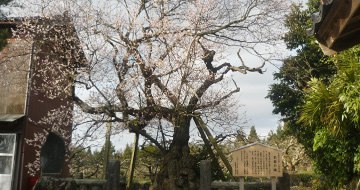
This plum tree can be found in the garden of a privately-owned house located en route to Mano Gogyo Mausoleum. The site is believed to have been the residence of the descendants of an Imperial palanquin bearer who served Emperor Juntoku when he moved to Sado. The plum tree is thought to have been planted by the Emperor, himself. Estimated at about 750 years old, the tree appears to be holding the large stone at its base and it is thus called "Stone Cuddling Plum." Fresh pale pink flowers come into bloom around mid-March every year.
-
Approximately 12 minutes by carDestination F
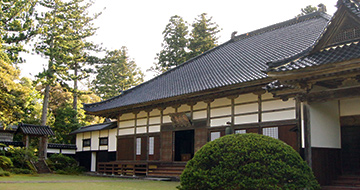
Considered to have been established in 764, Sado Kokubunji Temple (provincial temple) was burnt down several times after lightning strike and great fire. The present-day Kokubunji Temple is located to the east of the old site. The year of establishment is not clearly known, but it is said to be the early Edo Period (early 17th century). Within the grounds lie the main hall as well as Niomon gate with a pair of statues of Buddha's guardians, Rurido Hall, Bell Tower, and so on. The main image of Buddha, a wood statue of Yakushinyorai (Bhaisajyaguru: the Buddha of healing and medicine) survived fires and is installed in the storehouse.
-
Approximately 5 minutes by carDestination G
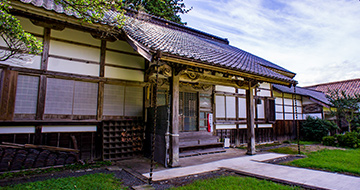
Sesonji Temple houses a lovely green garden on its ancient grounds. Six temple buildings, including the main hall, are designated as Japan's Tangible Cultural Properties. Morikuni Endo, who was a member of Emperor Juntoku's troop and accompanied to Sado along with Emperor Juntoku, encountered Nichiren (founder of Nichiren School of Buddhism, exiled to Sado) and became a fervent follower of him. Sesonji Temple is a meditation hall established with Nikko, a leading disciple of Nichiren, as the head of the temple. The temple houses a mandala drawn by Nichiren Shonin, and also a drawing of Daikokuten (god of wealth) which Nichiren drew at the beach of Shibute (Mano) at the time of his departure from Sado after being pardoned. Mahori Hogan Yoshitaka, a master painter, donated a painting entitled Shibuya Daikokuten. Sesonji Temple is one of the temples on Sado's Seven Gods of Fortune pilgrimage route. Sesonji Temple is also known for its beautiful azalea.
-
Approximately 5 minutes by carDestination H
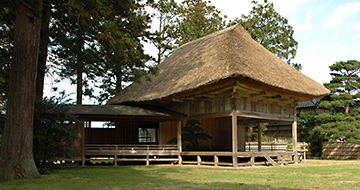
Daizen Shrine sits in a rustic setting resembling the landscape of Asuka in Nara Prefecture. Honma Yamashironokami, the manor's lord, initiated the enshrinement of Suketomo Hino (an exiled court noble) and Daizenbo (an ascetic hermit) together, while Miketsuokami (the god of food) is enshrined at the main building. When Kumawakamaru, the son of Suketomo Hino, came over to Sado to revenge his father's death by execution, Daizenbo helped him escape and was, consequently, executed. This shrine reputedly houses Daizenbo in order to calm his revengeful ghost. Reconstructed in 1846, the Noh stage with its thatched and hipped roof (designated a Niigata Prefecture Tangible Folk Cultural Asset), is one of the four Noh stages in the Kuninaka area where Noh performances were regularly held. It is said to be the oldest Noh stage still in existence in Sado. At present, Noh performances are offered at a festival on the 18th of April; and in June, Noh and Sagi School's Kyogen performances take place.
-
5 minutes by carGoal!
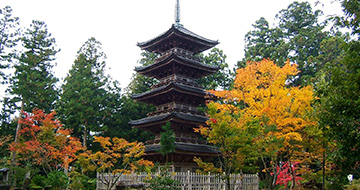
Tamemori Endo (Abutsubo Nittoku Shonin) served Nichiren upon being exiled to Sado and became an avid believer of the Hokke mantra. Together with his wife, Sen-nichini (a Buddhist nun), he opened his residence as a temple in 1278, and this is said to be the origin of Myosenji Temple. The temple used to be a residence of the Takeda Honma clan, deputy governor of Sado, and the ambience of a castle still remains. On site stands the only five-story pagoda in Niigata Prefecture, as well as the grave of Suketomo Hino, who was forced into exile on Sado after the Shochu Incident.